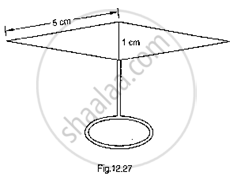Advertisements
Advertisements
Question
Find the area of the blades of thc magnetic compass shown in Fig.. 12.27. (Take √11 = 3.32).

Solution
Area of the blades of magnetic compass = Area of ΔADB + Area of ΔCDB
Now, for area of ΔADB
Let, 2s = AD + DB + BA (Perimeter of ΔADB)
Semi perimeter (S)= `1/2(5+1+5)=11/2 cm`
By using heron’s formulae
Now, area of ΔADB `=sqrt(s(s-ad)(s-bd)(s-ba))`
`sqrt(11/2(11/2-5)(11/2-1)(11/2-5))`
`=2.49 cm^2`
= Also, area of triangle ADB = 𝐴𝑟𝑒𝑎 𝑜𝑓 Δ𝑙𝑒 𝐶𝐷𝐵
∴ Area of the blades of magnetic compass
= 2×(𝑎𝑟𝑒𝑎 𝑜𝑓 Δ𝐴𝐷𝐵)
= 2 × 2.49
= `4.98 m^2`
APPEARS IN
RELATED QUESTIONS
If the coordinates of two points A and B are (3, 4) and (5, – 2) respectively. Find the coordniates of any point P, if PA = PB and Area of ∆PAB = 10
Find a relation between x and y if the points (x, y), (1, 2) and (7, 0) are collinear.
Prove that the points (2,3), (-4, -6) and (1, 3/2) do not form a triangle.
Show that the points O(0,0), A`( 3,sqrt(3)) and B (3,-sqrt(3))` are the vertices of an equilateral triangle. Find the area of this triangle.
Find the area of Δ ABC whose vertices are:
A (1,2) B (-2,3) and C (-3,-4)
Find the value of p for which the points (−5, 1), (1, p) and (4, −2) are collinear.
The table given below contains some measures of the right angled triangle. Find the unknown values.
| Base | Height | Area |
| 5 feet | ? | 20 sq.feet |
Find the coordinates of the point Q on the x-axis which lies on the perpendicular bisector of the line segment joining the points A(–5, –2) and B(4, –2). Name the type of triangle formed by the points Q, A and B.
If `D((-1)/2, 5/2), E(7, 3)` and `F(7/2, 7/2)` are the midpoints of sides of ∆ABC, find the area of the ∆ABC.
Find the cost of laying grass in a triangular field of sides 50 m, 65 m and 65 m at the rate of Rs 7 per m2.
